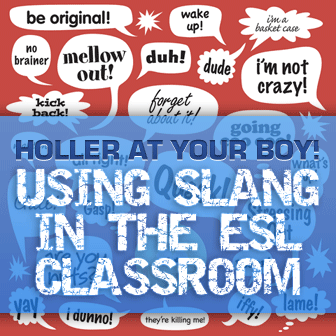Holler at Your Boy! Using Slang in the ESL Classroom


Teaching English as a second language can be extremely rewarding, from introducing students to the ins and outs of reading, speaking, and writing to witnessing them learn and grow more confident in themselves. It is always exciting to see ESL students engage with others and apply the new knowledge they've learned in the classroom during their conversations. But teaching a new language to a student is about more than just technical skills like grammar - it's about integrating them into a new culture and way of life. If you're teaching ESL/Conversations classes, use these everyday English worksheets to expose them to engaging conversations, cultural tips, and commonly-used phrases that will help them master English.

Learning new vocabularly is one thing, but knowing how to repsond in real-life situations is another. This worksheet will give experienced ESL students some practice with everyday responses like accidentally bumping into someone or seeing someone drop something and picking it up for them. They will have a list of appropriate responses and will need to match the best option to the situation. Teachers can even have the students pair up and act out the situations and use the expressions on the worksheet to respond accordingly.
If you teach an ESL/Conversation class, you need to bookmark this resource. This chart contains the 25 most common verbs used in the English language, including past, present, and future tenses. Not only is this resource excellent to introduce new vocabularly to students, but it can serve as the base for many activities. For instance, teachers can have students write out sentences containing words on the list. Or, students can use it to help them practice conversations with their peers.
Everyone has pet peeves, no matter what langauge you speak. ESL students will love getting to speak up about what annoys them most with this activity. The class will go over a list of common annoyances, and students will have the chance to explain how those things make them feel (i.e. What do you think about slow walking shoppers?). It's also a good idea to go over "negative adjectives" during this activity to introduce or remind students of common vocabularly used when describing something that bothers a person, such as drive you crazy, make you mad, and are frustrating. Finally, students will practice conversations using these phrases. (For more tips on how to teach expressions, check out this article on teaching pragmatism in conversation).
One of the most perplexing parts of learning a new language is the slang. From 'sup to okie-dokie, Americans have goofy ways of saying the most common phrases, and ESL students will love getting to know these terms and incorproate them into their vocabularly. This is a simple, yet comprehensive guide that covers how to say hello, goodbye, how are you?, good, bad, and more in English slang. Teachers can use this as a fun warmer or as an extra resource to hand out to students for extra practice.

Expecting teens to speak in "proper English" can be unrealistic, but teaching them colloquial and informal expressions is one way to empower them to express themselves in a way that makes them feel comfortable. This everyday English worksheet includes common expressions used in standard English, along with their meanings. Students will be asked to match the informal expressions with their defintions, as well as complete sentences with the appropriate colloquial phrases.
Once you introduce colloquial and informal expressions to your ESL students, you can expose them to informal contractions. You know - the kind that make teachers' ears bleed. Words like "wanna" and "gonna" may not be proper, but they are used more often than the words they come from in standard English, so they are important to introduce to students as they advance in their ESL education. Of course, it's important to teach them when it's appropriate to use informal contractions (hanging out with friends, at a party), versus when it's not (speaking to an adult, in a work place).
No matter where your students live, they all need to know how to navigate everyday dialogue. From visiting the doctor's office to checking in a hotel to reporting an accident to going shopping, these situations will help them practice how to respond in English with model conversations. Students can break off into pairs to act out the situation, or teachers can practice them one on one with students to gauge their understanding of the vocabularly. This can be an excellent warmer or introduction to a topic like travelling.
This is the ultimate guide to everyday expressions, idoms, and phrases that are used in standard English! The list highlights common conversational terms, and each one of them links to the definition of the phrase. While these phrases are universally known to those who speak English, their meanings are not necessarily obvious to those who are learning it as a second language. In fact, students often find these phrases humorous and surpising when they learn what they really mean. Examples include: